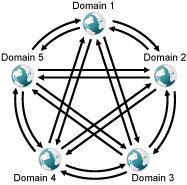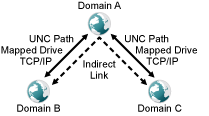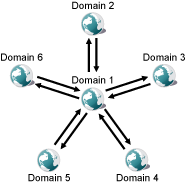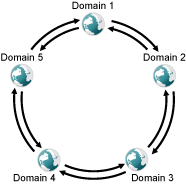10.1 Understanding Link Configuration
In GroupWise, a link is defined as the information required to route messages between domains, post offices, and gateways in a GroupWise system. Initial links are created when domains, post offices, and gateways are created. The following topics help you understand link configuration:
10.1.1 Domain-to-Domain Links
The primary role of the MTA is to route messages from one domain to another. Domain links tell the MTA how to route messages between domains. Domain links are stored in the domain database (wpdomain.db). There are three types of links between source and destination domains:
As an alternative to configuring individual links between individual domains throughout your GroupWise system, you can establish a system of one or more routing domains. See Section 42.3.1, Using Routing Domains.
Direct Links
In a direct link between domains, the source domain’s MTA communicates directly with the destination domain’s MTA. If it is using a TCP/IP link, the source domain MTA communicates messages to the destination domain MTA by way of TCP/IP, which does not require disk access by the source MTA in the destination domain. This is the recommended configuration, and is the only option for domains on Linux.
If a Windows domain is using a mapped or UNC link, the source domain MTA writes message files into the destination domain MTA input queue, which does require disk access by the source MTA in the destination domain. For additional details about the configuration options for direct links, see Section 10.1.3, Link Protocols for Direct Links.

Direct links can be used between all domains. This is a very efficient configuration but might not be practical in a large system.

Indirect Links
In an indirect link between domains, the source domain’s MTA routes messages through one or more intermediate MTAs in other domains to reach the destination domain’s MTA. In other words, an indirect link is a series of two or more direct links.
In large systems, direct links between each pair of domains might be impractical, so indirect links can be common. Properly configured links optimize message flow throughout your GroupWise system. A variety of indirect link configurations are possible, including:
Simple Indirect Links
In simplest form, an indirect link can be used to pass messages between two domains that are not directly linked.

Star Configuration
In a star configuration, one central domain is linked directly to all other domains in the system. All other domains are indirectly linked to each other through the central domain.

If you have more than ten domains, you might want to designate the central domain as a routing domain. The sole function of a routing domain is to transfer messages between other domains; it has no post offices of its own. See Section 42.3.1, Using Routing Domains.
The major drawback of the star configuration is that the central domain is a single point of failure.
Two-Way Ring Configuration
In a two-way ring configuration, each domain is directly linked to the next and previous domains in the ring and indirectly linked to all other domains in the system.

An advantage of the two-way ring configuration is that it has no single point of failure. A disadvantage is that, depending on the size of the system, a message might go through several domains before arriving at its destination. A two-way ring works well in a system with five domains or less because transferring a message never requires more than two hops.
Combination Configuration
These three basic link configurations can be combined in any way to meet the needs of your GroupWise system.
Gateway Links
In a gateway link between domains, the sending domain’s MTA must route the message through a gateway to reach its destination. Gateways can be used to:
-
Link domains within your GroupWise system. See Using Gateway Links between Domains.
-
Link your GroupWise system to another GroupWise system through an external domain. See
Using Direct Links
inConnecting to Other GroupWise Systems
in the GroupWise 2012 Multi-System Administration Guide
For more information, see the GroupWise Gateways Documentation Web site.
NOTE:GroupWise gateways are legacy products and are not supported with the current GroupWise version.
You cannot locate a post office across a gateway link from its domain.
10.1.2 Domain-to-Post-Office Links
Between a domain and its post offices, all links must be direct links. There are no alternative link types between a domain and its post offices.
10.1.3 Link Protocols for Direct Links
The link protocol of a direct link between domains determines how the MTAs for the domains communicate with each other across the link. When you create a new domain, you must link it to an existing domain. This creates the initial domain-to-domain link.
Between a domain and a post office, the link protocol determines how the MTA transfers messages to the post office. Messages do not flow directly from one post office to another within a domain. Instead, they are routed through the domain. When you create a new post office, you must specify which domain it belongs to. This creates the initial domain-to-post-office link.
There are three link protocols for direct links between domains and between a domain and its post offices:
NOTE:On Linux, TCP/IP links are required. On Windows, they are recommended.
TCP/IP Links
Domain-to-Domain TCP/IP Links
In a TCP/IP link between domains, the source MTA and the destination MTA communicate by way of TCP/IP rather than by writing message files into queue directories. The source MTA establishes a TCP/IP link with the destination MTA and transmits whatever messages need to go to that domain. The destination MTA receives the messages and routes them on to local post offices or to other domains as needed. During the process, message files are created in the gwinprog directory for backup purposes and are deleted when the TCP/IP communication process is completed.
Domain-to-Post-Office TCP/IP Links
In a TCP/IP link between a domain and a post office, you must configure both the POA and the MTA for TCP/IP. The source MTA establishes a TCP/IP link with the destination POA and transmits whatever messages need to go to that post office. The destination POA receives the messages and delivers them into mailboxes in the post office. During this process, message files are created in the POA input queue for backup purposes and are deleted when delivery is completed.
Mapped Links
Mapped links apply only to domains on Windows servers.
Domain-to-Domain Mapped Links
In a mapped link between domains, the location of the destination domain is specified in the following format:
drive:\domain_directory
The source MTA writes message files into its output queue at the following location:
drive:\domain_directory\wpcsin
The files are sent as input for the destination domain’s MTA. Because drive mappings are changeable, you can move the domain directory structure, map its new location to the original drive letter, and the domain-to-domain link is still intact.
Domain-to-Post-Office Mapped Links
In a mapped link between a domain and a post office, the location of the post office is specified in the following format:
drive:\post_office_directory
The MTA writes message files into its output queue at the following location:
drive:\post_office_directory\wpcsout
The files are sent as input for the post office’s POA. Because drive mappings are changeable, you can move the post office directory structure, map its new location to the original drive letter, and the domain-to-post-office link is still intact.
UNC Links
UNC links apply only to domains on Windows servers.
Domain-to-Domain UNC Links
In a UNC link between domains, the location of the destination domain is specified in the following format:
\\server\volume\domain_directory
The source MTA writes message files into its output queue at the following location:
\\server\volume\domain_directory\wpcsin
The files are sent as input for the destination domain’s MTA. Because UNC paths represent absolute locations on your network, if you move the domain to a new location, you need to edit the link to match.
Domain-to-Post-Office UNC Links
In a UNC link between a domain and a post office, the location of the post office is specified in the following format:
\\server\volume\post_office_directory
The MTA writes message files into its output queue at the following location:
\\server\volume\post_office_directory\wpcsout
The files are sent as input for the post office’s POA. Because UNC paths represent absolute locations in your network, if you move the post office to a new location, you need to edit the link to match.